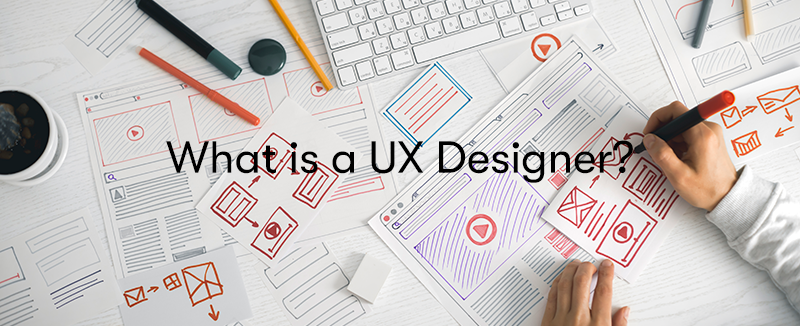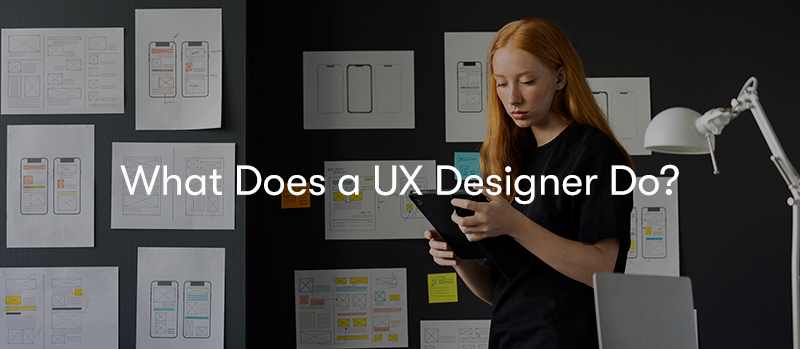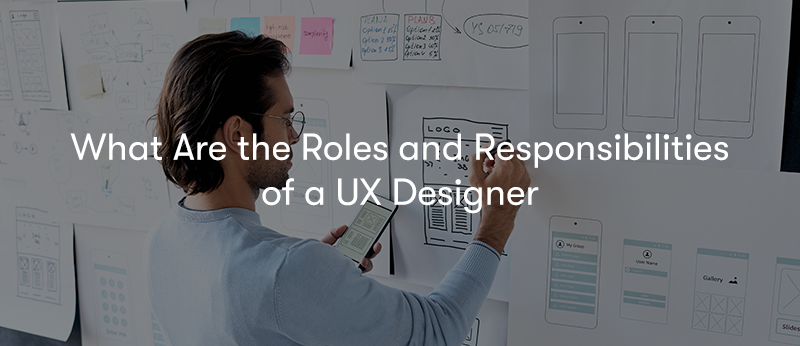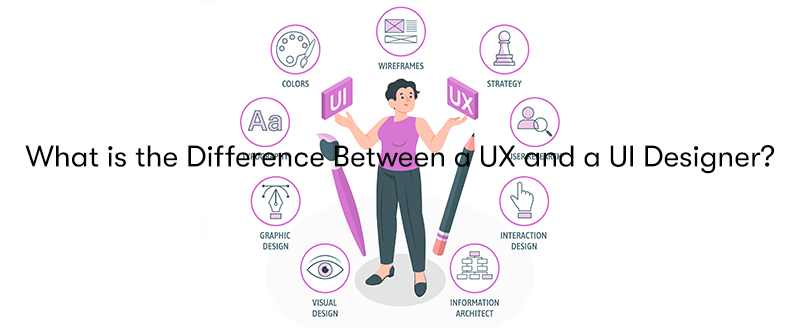What is a UX Designer?
Welcome to the world of digital design, where the UX (User Experience) Designer reigns supreme. In this ever-evolving landscape, UX Designers are the architects of online interactions, dedicated to creating seamless, user-centric experiences. They embark on a journey of understanding user behaviour, translating it into intuitive interfaces, and conducting meticulous usability testing. These professionals are the champions of empathy, ensuring every click and swipe aligns with user needs and expectations. So, join us as we delve into the realm of UX Design, where innovation and user satisfaction collide, shaping the future of digital interaction.
What is a UX Designer?

A UX Designer is a professional who focuses on creating digital and physical products and services that provide a positive and seamless experience for users. The primary goal of a UX Designer is to ensure that the product or service is intuitive, functional, and enjoyable to use, ultimately meeting the needs and expectations of the target audience. Here are some key responsibilities and activities associated with UX Design:
User Research
UX Designers conduct research to understand the target users' needs, behaviours, and preferences. This may involve interviews, surveys, usability testing, and data analysis.
Information Architecture
They create the structure and organisation of information within a product or service, ensuring that users can easily find what they're looking for.
Wireframing and Prototyping
UX Designers often create wireframes and prototypes to visually represent a product's layout and functionality. These low-fidelity designs help in testing and refining ideas before moving on to high-fidelity designs.
Interaction Design
They define how users interact with a product by designing user interfaces (UI) and specifying their interactions with elements like buttons, menus, and forms.
Usability Testing
UX Designers conduct usability tests to gather feedback from real users, identify issues, and make improvements to the design based on user feedback.
Visual Design
While UX Design primarily focuses on the user's overall experience, some UX Designers also handle the visual aspects of a product, including colour schemes, typography, and graphical elements. However, this may overlap with the responsibilities of a UI (User Interface) Designer.
Collaboration
UX Designers often work closely with cross-functional teams, including UI Designers, developers, product managers, and stakeholders, to ensure that the design aligns with the project's goals and constraints.
Accessibility
They pay attention to designing products that are accessible to users with disabilities, ensuring that everyone can use and interact with the product effectively.
Continuous Improvement
UX Designers continuously iterate on designs based on user feedback and evolving project requirements, striving to enhance the user experience throughout the product's lifecycle.
Overall, a UX Designer plays a critical role in bridging the gap between user needs and business goals, ensuring that the final product or service is user-centric, functional, and engaging. Their work is essential in creating products that are not only usable but also provide a positive emotional and cognitive experience for users.
What Does a UX Designer Do?

A UX Designer's role encompasses a range of activities focused on creating and enhancing the user experience of a product or service. Here is a detailed breakdown of what a UX Designer typically does:
User Research:
- Research to understand the target audience's needs, goals, and behaviours.
- Gathers user feedback through methods like interviews, surveys, and observations.
- Analyses data and user feedback to identify trends and insights.
User Persona Development:
- Creates user personas, fictional representations of typical users, to help the design team empathise with and design for specific user groups.
Information Architecture:
- Organises and structures information within a product or website to ensure easy navigation and content discovery.
- Develops sitemaps and content hierarchies.
Wireframing and Prototyping:
- Creates low-fidelity wireframes and prototypes to visualise the layout and functionality of the product.
- These early designs help in testing and refining concepts without investing heavily in development.
Interaction Design:
- Designs the user interface (UI) elements, such as buttons, menus, forms, and navigation.
- Defines how users interact with these elements to achieve their goals.
Usability Testing:
- Plans and conducts usability tests with real users to identify usability issues and gather feedback.
- Iterates on design based on the insights gained from usability testing.
Accessibility:
- Ensures the product is designed to be accessible to users with disabilities, complying with accessibility standards (e.g., WCAG guidelines).
Visual Design:
- In some cases, UX Designers also handle visual aspects like colour schemes, typography, and graphical elements. However, this responsibility often overlaps with UI Design.
Collaboration:
- Works closely with cross-functional teams, including UI Designers, developers, product managers, and stakeholders, to ensure the design aligns with project goals and constraints.
User-Centred Design:
- Advocates for the user throughout the design process, making design decisions based on user needs and feedback rather than personal preferences.
Continuous Improvement:
- Iteratively improves the user experience based on ongoing feedback and data analysis.
- Keeps up with industry trends and best practices in UX design.
Documentation:
- Creates design documentation, such as design guidelines, style guides, and design specifications, to ensure consistency in the design implementation.
User Testing and Validation:
- Conducts usability tests to validate design decisions and ensure the final product meets user needs and expectations.
Overall, a UX Designer's role is to bridge the gap between user needs and business goals, aiming to create user-friendly, efficient, and enjoyable products and services. Their work is crucial in ensuring the design process is iterative, user-centric, and results in a positive user experience.
What is UX Design and Why is it Necessary?

UX Design, which stands for User Experience Design, is a multidisciplinary field focused on creating products, services, or systems that provide users a positive and meaningful experience. It encompasses a wide range of activities and considerations aimed at understanding, designing for, and improving the interactions between users and a product or service.
UX Design aims to make products more user-friendly, efficient, and enjoyable while meeting the needs of both users and businesses. Here are key aspects of UX Design and why it is necessary:
User-Centric Approach
UX Design starts by placing the user at the centre of the design process. It emphasises understanding users' goals, preferences, and pain points to create solutions that address their needs.
Usability
UX Design focuses on ensuring that products are easy to use and navigate. It aims to minimise user frustration and confusion, resulting in a smoother and more efficient user experience.
Problem Solving
UX Designers analyse and solve complex problems related to user interactions, information architecture, and user interface design. They strive to simplify tasks and workflows.
Emotional Engagement
Beyond usability, UX Design aims to create emotionally engaging experiences. A positive emotional connection can lead to user satisfaction, loyalty, and brand advocacy.
Business Alignment
UX Design considers business objectives and goals. It ensures that user needs align with the organisation's objectives, leading to a win-win situation where both users and businesses benefit.
User Retention
A well-designed user experience can lead to higher user retention rates. Satisfied users are likelier to return to a product or service and recommend it to others.
Competitive Advantage
In today's competitive market, offering a superior user experience can set a product or service apart from competitors. Users are more likely to choose products that are easy and enjoyable to use.
Accessibility and Inclusivity
UX Design emphasises creating products that are accessible to users of all abilities, ensuring inclusivity and compliance with accessibility standards.
Iterative Process
UX Design is an iterative process that involves continuous improvement. Designers gather user feedback, analyse data, and adjust the design to enhance the user experience over time.
Risk Mitigation
By conducting user research and testing early in the design process, UX Designers can identify and address issues before they become costly to fix during development or after a product's launch.
Cost Savings
Investing in UX Design upfront can lead to cost savings in the long run. Fixing usability issues or making significant design changes after a product is developed is often more expensive and time-consuming.
In summary, UX Design is necessary because it ensures that products and services are user-friendly, aligned with business objectives, and capable of creating positive user experiences. It addresses the evolving needs of users and helps organisations stay competitive in a user-centric world. Ultimately, UX Design aims to create products that users love and find valuable, leading to user satisfaction, loyalty, and business success.
Do UX Designers Make Good Money in the UK?

Yes, UX Designers can earn a competitive salary in the United Kingdom. However, the exact salary can vary based on several factors, including the designer's level of experience, location within the UK, their specific industry, and the company they work for.
Here are some general salary ranges for UX Designers in the UK:
- Junior UX Designer: Junior UX Designers with limited experience typically earn an annual salary ranging from £20,000 to £40,000, depending on location and company.
- Mid-Level UX Designer: UX Designers with a few years of experience can earn salaries in the range of £40,000 to £60,000 per year.
- Senior UX Designer: Senior UX Designers with significant experience and expertise can command salaries ranging from £60,000 to £90,000 or more annually.
- Lead UX Designer or UX Manager: Those in leadership roles within UX, such as Lead UX Designers or UX Managers, can earn salaries that exceed £90,000 per year, especially in larger organisations.
Location is a significant factor influencing salary levels. Salaries tend to be higher in major cities like London, where the cost of living is generally higher than in other parts of the UK. However, salaries can still be competitive in other regions, especially in tech hubs like Manchester, Edinburgh, and Bristol.
Additionally, the industry in which a UX Designer works can impact their earning potential. UX Designers in industries with a strong emphasis on user experience, such as technology, finance, and e-commerce, may command higher salaries than those in less UX-focused sectors.
It's essential to note that these figures are approximate and can vary based on the individual's qualifications, the specific job role, and the employer's compensation policies. Salaries can also change over time as the demand for UX Designers continues to grow, so it's a good idea to research current salary trends and negotiate your compensation based on your skills and experience when seeking a UX Design position in the UK.
What is a Full Stack UX Designer?
A Full-stack UX Designer is a professional with expertise in both the front-end (user interface) and back-end (user experience) aspects of design. This role combines the skills of a UX Designer and a UI Designer, allowing the individual to work comprehensively on all aspects of the user experience, from research and information architecture to visual design and implementation. Here are some key characteristics and responsibilities of a Full Stack UX Designer:
User-Centred Design
Like traditional UX Designers, full-stack UX Designers prioritise the needs and preferences of users. They conduct user research, create personas, and ensure the product or service meets user requirements.
Information Architecture
They work on structuring and organising the content and navigation within a product to ensure that users can find information easily.
Interaction Design
Full-stack UX Designers design the interactions users have with the product. They define how users can perform actions, such as clicking buttons, navigating menus, and filling out forms.
Visual Design
In addition to the user experience, they are proficient in visual design, including creating visually appealing user interfaces. This involves choosing colour schemes, typography, icons, and other graphical elements.
Front-End Development
Full-stack UX Designers often know of front-end web development technologies such as HTML, CSS, and JavaScript. This enables them to create interactive prototypes and collaborate effectively with developers.
Prototyping
They create interactive prototypes that allow stakeholders and users to visualise and test the product's functionality and design.
Usability Testing
Full-stack UX Designers plan and conduct usability tests to gather user feedback and validate design decisions.
Collaboration
They work closely with cross-functional teams, including developers, product managers, and stakeholders, to ensure the design aligns with project goals and technical constraints.
Iterative Improvement
Full-stack UX Designers continuously iterate on the design based on user feedback and evolving project requirements.
Responsiveness and Accessibility
They ensure that designs are responsive to different devices and screen sizes and follow accessibility guidelines to make products inclusive to users with disabilities.
The term "Full Stack" in Full Stack UX Designer is borrowed from the world of web development, where "Full Stack Developers" are skilled in both front-end and back-end development. Similarly, a Full Stack UX Designer has a broad skill set that spans various aspects of the user experience and design process.
This role can be especially valuable in smaller teams or start-ups where individuals are expected to wear multiple hats. However, in larger organisations, it may also be beneficial for collaboration and communication between UX Designers and UI Designers, as the Full Stack UX Designer can bridge the gap between the two disciplines.
What Are the Roles and Responsibilities of a UX Designer?

The roles and responsibilities of a UX Designer can vary depending on the organisation, project, and specific job title. However, here are the core roles and responsibilities typically associated with a UX Designer:
User Research:
- Conduct user research to understand the target audience's needs, behaviours, and preferences.
- Use various research methods, such as interviews, surveys, observations, and usability testing, to gather insights.
Persona Development:
- Create user personas, fictional representations of typical users, to help the design team empathise with and design for specific user groups.
Information Architecture:
- Organise and structure information within a product or website to ensure easy navigation and content discovery.
- Develop sitemaps, content hierarchies, and navigation flows.
Wireframing and Prototyping:
- Create low-fidelity wireframes and prototypes to visualise the layout and functionality of the product.
- Test and refine design concepts before moving on to high-fidelity designs.
Interaction Design:
- Design user interfaces and specify users' interactions with elements like buttons, menus, forms, and navigation.
- Ensure that the design aligns with user goals and behaviours.
Usability Testing:
- Plan and conduct usability tests with real users to identify usability issues and gather feedback.
- Use test results to make iterative improvements to the design.
Accessibility:
- Ensure the product is designed to be accessible to users with disabilities, complying with accessibility standards (e.g., WCAG guidelines).
Collaboration:
- Work closely with cross-functional teams, including UI Designers, developers, product managers, and stakeholders, to ensure the design aligns with project goals and constraints.
User-Centred Design:
- Advocate for the user throughout the design process, making design decisions based on user needs and feedback rather than personal preferences.
Visual Design:
- In some cases, UX Designers also handle visual aspects like colour schemes, typography, and graphical elements. However, this responsibility often overlaps with UI Design.
Documentation:
- Create design documentation, such as design guidelines, style guides, and design specifications, to ensure consistency in the design implementation.
User Testing and Validation:
- Conduct usability tests to validate design decisions and ensure the final product meets user needs and expectations.
Continuous Improvement:
- Iteratively improve the user experience based on ongoing feedback and data analysis.
- Keep up with industry trends and best practices in UX design.
Overall, a UX Designer's primary role is to bridge the gap between user needs and business goals, ensuring that the final product or service is user-centric, functional, and engaging. Their work is crucial in creating products that are not only usable but also provide a positive emotional and cognitive experience for users.
What Qualifications Are Needed to Work as a UX Designer?

To work as a UX Designer, you don't necessarily need a specific degree, but having the right qualifications, skills, and knowledge is crucial for success. Here are the qualifications and prerequisites that are typically helpful for becoming a UX Designer:
Educational Background
While there's no strict educational requirement, many UX Designers have bachelor's degrees in related fields, such as:
- User Experience Design.
- Human-Computer Interaction (HCI).
- Interaction Design.
- Graphic Design.
- Psychology.
- Cognitive Science.
- Computer Science.
- Information Science.
Courses and Training
Consider enrolling in formal UX design courses or boot camps offered by universities, online platforms, or specialised UX design schools. These programs often provide hands-on experience and can help you build a strong portfolio.
Portfolio
Building a portfolio of projects is crucial. It showcases your skills and practical experience to potential employers. Include case studies that demonstrate your ability to solve real-world UX problems.
Skills
Develop proficiency in the following skills:
- User research and usability testing.
- Information architecture and wireframing.
- Interaction design and prototyping.
- Visual design (optional but valuable).
- UX/UI design tools like Sketch, Adobe XD, Figma, or others.
- HTML, CSS, and basic JavaScript (helpful for understanding front-end development).
- Collaboration and communication skills for working with cross-functional teams.
Familiarity with UX Methods and Principles
Understand and apply core UX principles, methods, and best practices, such as user personas, user journeys, usability heuristics, and design thinking.
Networking
Attend UX-related conferences, meetups, and networking events to connect with other professionals in the field and stay updated on industry trends.
Certifications
Consider obtaining certifications in UX design from reputable organisations like Nielsen Norman Group (NN/g) or the Interaction Design Foundation (IDF). While not mandatory, certifications can enhance your credibility.
Internships and Entry-Level Positions
Starting with internships or entry-level positions in UX design or related roles (e.g., UX research, UI design) can provide practical experience and help you build your skills.
Continuous Learning
UX design is a continuously evolving field. Stay updated by reading books, blogs, and industry publications and taking online courses or attending workshops.
Soft Skills
Develop soft skills such as empathy, problem-solving, critical thinking, and effective communication, as these are essential for understanding and meeting user needs.
Remember that UX design is a multidisciplinary field with various paths to entry. Your unique combination of education, skills, and experience will set you apart in the job market. Building a strong portfolio that showcases your ability to create user-centred solutions is particularly important in securing UX design roles.
Can You do an Apprenticeship in UX Design in the UK?
Yes, you can undertake a UX Design apprenticeship in the UK. As of my last update in September 2021, the UK government has been actively promoting apprenticeships across various sectors, including digital and tech disciplines such as UX Design.
The specifics of available apprenticeships, their content, and duration might vary, but typically, a UX Design apprentice will learn about:
1. User Research: Understanding users, their needs, and behaviours.
2. Design: Creating wireframes, prototypes, and high-fidelity designs.
3. User Testing: Evaluating designs by testing them with users.
4. Collaboration: Working within multidisciplinary teams, including developers, product managers, and other stakeholders.
5. Tools & Technologies: Gaining proficiency in popular design and prototyping tools like Sketch, Figma, Adobe XD, and others.
To find a UX Design apprenticeship in the UK:
1. National Apprenticeship Service: Visit the official apprenticeship website to search for UX Design apprenticeships and get more details about the application process.
2. Local Providers: Some colleges, universities, or private training providers offer UX Design or related digital apprenticeships. Reach out to institutions in your area for more details.
3. Direct Employers: Some companies might run their own apprenticeship programs. It's worth checking out companies' career pages, especially those in the tech and digital sectors.
4. Networking: Attend UX or digital design events, workshops, or meetups in your area. Networking often leads to opportunities and gives you a sense of the local job market.
When considering an apprenticeship, always review the course content, check for reviews or testimonials from past apprentices, and ensure the apprenticeship will provide the skills and experience you're looking to achieve.
What is the Difference Between a UX and a UI Designer?

UX Designers and UI Designers are both crucial roles in the design of digital products, but they have distinct responsibilities and focus areas. Here's a breakdown of the key differences between UX and UI Designers:
UX Designer
Focus: UX Designers primarily focus on the overall user experience, emphasising how a user interacts with a product or service. Their primary concern is ensuring the product is functional, efficient, and user-friendly.
Responsibilities:
- User Research: Conducting user research to understand user needs, behaviours, and pain points.
- Information Architecture: Organising and structuring content and navigation to facilitate easy access to information.
- Wireframing and Prototyping: Creating low-fidelity designs and interactive prototypes to test and refine ideas.
- Interaction Design: Defining how users interact with the product's elements, such as buttons, menus, and forms.
- Usability Testing: Conducting usability tests with real users to gather feedback and make improvements.
- User-Centred Design: Advocating for the user throughout the design process to ensure their needs are met.
Skills: UX Designers need skills in research, information architecture, wireframing, interaction design, usability testing, and a deep understanding of user psychology and behaviour.
Outcome: The primary goal of a UX Designer is to create a product or service that provides a positive, efficient, and effective user experience.
UI Designer:
Focus: UI Designers concentrate on the visual aspects of the product, with a specific emphasis on the look and feel. They ensure the interface is visually appealing, intuitive, and consistent with the brand's style and identity.
Responsibilities:
- Visual Design: Selecting colour schemes, typography, icons, and graphical elements to create an aesthetically pleasing interface.
- Layout Design: Determining the placement and arrangement of UI elements for optimal usability and visual harmony.
- Icon and Graphic Design: Creating icons and graphical elements that enhance the user interface's visual appeal.
- Style Guides: Developing and maintaining design guidelines to ensure consistency across the product.
Skills: UI Designers need strong skills in graphic design, typography, colour theory, visual hierarchy, and an understanding of how to create visually engaging interfaces.
Outcome: The primary goal of a UI Designer is to craft a visually appealing and cohesive user interface that complements the overall user experience.
In practice, UX and UI Designers often collaborate closely, and their roles can overlap to some extent. For example, a UX Designer might create wireframes and prototypes that serve as a foundation for the UI Designer's work. Effective collaboration between these two roles is crucial for creating user-friendly and visually appealing products.
In summary, while UX Designers focus on the broader user experience, including research, usability, and functionality, UI Designers concentrate on the aesthetics and visual aspects of the user interface. Both roles are essential for delivering a successful digital product.
Where Can You Learn More About UX Design?
Our BCS Foundation Certificate In User Experience training course is perfect for anyone who wants to increase their knowledge of User Experience. The BCS User Experience course will teach you the UX methodology, best practices, techniques, and a strategy for creating a successful user experience. The course will cover the following topics:
- Guiding Principles
- User Research
- Illustrating The Context Of Use
- Measuring Usability
- Information Architecture
- Interaction Design
- Visual Design
- User Interface Prototyping
- Usability Evaluation
Click the button below to find out more.

Final Notes on What UX Designers Do When Working
In the world of digital design, UX Designers are the unsung heroes who craft seamless, user-centric experiences. They delve deep into user behaviour, shaping information architecture, creating intuitive interfaces, and conducting usability tests to ensure products meet user needs. On the other side of the design coin, UI Designers add visual magic, giving life to these experiences with stunning visuals and consistency.
Together, these roles are the dynamic duo behind exceptional digital products. So, whether you're drawn to the user journey or the visual aesthetics, the UX and UI Designer partnership is the secret sauce for crafting products that users love. Cheers to the art and science of digital design!



